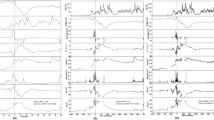Abstract
Geosynchronous magnetopause crossings (GMCs) were analyzed during geomagnetic storms on February 26, March 23, and April 23, 2023. GMC-associated magnetosheath intervals were identified using magnetic data acquired from the GOES-16 and GOES-17 spacecraft. A comparative analysis of various magnetopause models was performed on the base of solar wind conditions measured by the THEMIS-E spacecraft and the Wind interplanetary monitor. The analysis of models was based on statistical parameters for determining magnetosheath intervals. It was shown that for all three storms, the model presented in [1] demonstrated the best accuracy. For events of moderate magnetic storms against the background of small negative Bz component of the interplanetary magnetic field (IMF), good results are obtained with the model described in [2]. For extreme events with very high solar wind pressures and/or very strong negative IMF Bz, the model shown in [3] exhibits good accuracy, and satisfactory accuracy is also demonstrated by models presented in [4, 5]. It was shown that the accuracy of the models was affected by the following factors and effects: the choice of interplanetary monitor, the dependence of the model on the solar wind pressure, the Bz saturation effect, the dawn–dusk magnetopause asymmetry, and the effect of prehistory.





Similar content being viewed by others
REFERENCES
Kuznetsov, S.N. and Suvorova, A.V., An empirical model of the magnetopause for broad ranges of solar wind pressure and Bz IMF, Polar Cap Boundary Phenomena. NATO ASI Ser., 1998, vol. 509, pp. 51–61. https://doi.org/10.1007/978-94-011-5214-3_5
Lin, R.L., Zhang, X.X., Liu, S.Q., et al., A three-dimensional asymmetric magnetopause model, J. Geophys. Res., 2010, vol. 115, p. A04207. https://doi.org/10.1029/2009JA014235
Dmitriev, A.V., Suvorova, A.V., and Chao, J.-K., A predictive model of geosynchronous magnetopause crossings, J. Geophys. Res., 2011, vol. 116, p. A05208. https://doi.org/10.1029/2010JA016208
Shue, J.-H., Song, P., Russell, C.T., et al., Magnetopause location under extreme solar wind conditions, J. Geophys. Res., 1998, vol. 103, no. A8, pp. 17691–17700. https://doi.org/10.1029/98JA01103
Dmitriev, A.V. and Suvorova, A.V., Three-dimensional artificial neural network model of the dayside magnetopause, J. Geophys. Res., 2000, vol. 105, pp. 18909–18918. https://doi.org/10.1029/2000JA900008
Dredger, P.M., Lopez, R.E., and Collado-Vega, Y.M., Comparing magnetopause predictions from two mhd models during a geomagnetic storm and a quiet period, Front. Astron. Space Sci., 2023, vol. 10, p. 1213331. https://doi.org/10.3389/fspas.2023.1213331
Dmitriev, A.V., Suvorova, A.V., Chao, J.-K., et al., Anomalous dynamics of the extremely compressed magnetosphere during 21 January 2005 magnetic storm, J. Geophys. Res. Space Phys., 2014, vol. 119, pp. 877–896. https://doi.org/10.1002/2013JA019534
Lanzerotti, L.J., LaFleur, K., Maclennan, C.G., et al., Geosynchronous spacecraft charging in January 1997, Geophys. Res. Lett., 1998, vol. 25, no. 15, pp. 2967–2970. https://doi.org/10.1029/98GL00987
Wrenn, G.L., Rodgers, D.J., and Ryden, K.A., A solar cycle of spacecraft anomalies due to internal charging, Ann. Geophys., 2002, vol. 20, pp. 953–956. https://doi.org/10.5194/angeo-20-953-2002
Odenwald, S.F. and Green, J.L., Forecasting the impact of an 1859-caliber superstorm on geosynchronous Earth-orbiting satellites: Transponder resources, Space Weather, 2007, vol. 5.
Choi, H.-S., Lee, J., Cho, K.-S., et al., Analysis of GEO spacecraft anomalies: Space weather relationships, Space Weather, 2011, vol. 9, p. S06002. https://doi.org/10.1029/2006SW000262
Kuznetsov, S.N. and Suvorova, A.V., Solar wind control of the magnetopause shape and location, Radiat. Meas., 1996, vol. 26, no. 3, pp. 413–416.
Yang, Y.-H., Chao, J.K., Dmitriev, A.V., et al., Saturation of IMF Bz influence on the position of dayside magnetopause, J. Geophys. Res., 2003, vol. 108, no. A3. https://doi.org/10.1029/2002JA009621
Kuznetsov, S.N. and Suvorova, A.V., Shape of the magnetopause near geostationary orbit, Geomagn. Aeron., 1997, vol. 37, no. 3, pp. 1–11.
Kuznetsov, S.N., Suvorova, A.V., and Dmitriev, A.V., Shape and dimensions of the magnetopause: Relationship with parameters of the interplanetary medium, Geomagn. Aeron., 1998, vol. 38, no. 6, pp. 7–16.
Dmitriev, A.V., Suvorova, A.V., Chao, J.K., et al., Dawn-dusk asymmetry of geosynchronous magnetopause crossings, J. Geophys. Res., 2004, vol. 109, p. A05203. https://doi.org/10.1029/2003JA010171
Shue, J.-H., Song, P., Russell, C.T., et al., Toward predicting the position of the magnetopause within geosynchronous orbit, J. Geophys. Res., 2000, vol. 105, p. 2641. https://doi.org/10.1029/1999JA900467
Shue, J.-H., Song, P., Russell, C.T., et al., Dependence of magnetopause erosion on southward interplanetary magnetic field, J. Geophys. Res., 2001, vol. 106, no. A9, pp. 18777–18788. https://doi.org/10.1029/2001JA900039
Yang, Y.-H., Chao, J.K., Lin, C.-H., et al., Comparison of three magnetopause prediction models under extreme solar wind conditions, J. Geophys. Res., 2002, vol. 107, no. A1. https://doi.org/10.1029/2001JA000079
Dmitriev, A.V., Lin, R.L., Liu, S.Q., et al., Model prediction of geosynchronous magnetopause crossings, Space Weather, 2016, vol. 14, pp. 530–543. https://doi.org/10.1002/2016SW001385
Suvorova, A.V., Dmitriev, A.V., Chao, J.-K., et al., Necessary conditions for the geosynchronous magnetopause crossings, J. Geophys. Res., 2005, vol. 110, p. A01206. https://doi.org/10.1029/2003JA010079
Dmitriev, A.V., Chao, J.K., and Wu, D.-J., Comparative study of bow shock models using Wind and Geotail observations, J. Geophys. Res., 2003, vol. 108, no. A12. https://doi.org/10.1029/2003JA010027
Yermolaev, Yu.I., Yermolaev, M.Yu., Nikolaeva, N.S., et al., Interplanetary conditions for CIR-induced and MC-induced geomagnetic storms, Bulg. J. Phys., 2007, vol. 34, pp. 128–135.
Case, N.A. and Wild, J.A., The location of the Earth’s magnetopause: A comparison of modeled position and in situ cluster data, J. Geophys. Res. Space Phys., 2013, vol. 118, pp. 6127–6135. https://doi.org/10.1002/jgra.50572
Burton, R.K., McPherron, R.L., and Russell, C.T., An empirical relationship between interplanetary conditions and Dst, J. Geophys. Res., 1975, vol. 80, pp. 4204–4214.
ACKNOWLEDGMENTS
The author is grateful to NASA/GSFC ISTP (https://cdaweb.gsfc.nasa.gov/) for providing data on the Wind, GOES, and THEMIS spacecraft. The author also thanks the Kyoto World Data Center for providing the Dst and ASY/SYM indexes (https://wdc.kugi.kyoto-u.ac.jp/ aeasy/index.html).
Funding
The study was carried out as part of the research topic “Sun Research, Monitoring and Modeling of the Radiation Environment and Plasma Processes in the Heliosphere and near-Earth Space.”
Author information
Authors and Affiliations
Corresponding author
Ethics declarations
The author of this work declares that he has no conflicts of interest.
Additional information
Translated by M. Chubarova
Publisher’s Note.
Pleiades Publishing remains neutral with regard to jurisdictional claims in published maps and institutional affiliations.
Rights and permissions
About this article
Cite this article
Dmitriev, A.V. Geosynchronous Magnetopause Crossings in February–April 2023. Cosmic Res 62, 220–230 (2024). https://doi.org/10.1134/S001095252360035X
Received:
Revised:
Accepted:
Published:
Issue Date:
DOI: https://doi.org/10.1134/S001095252360035X




